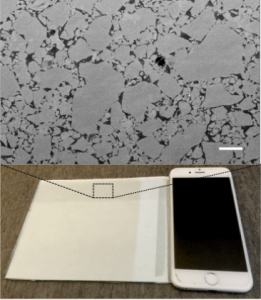Summary
Atomically thin 2D materials constitute promising building blocks for quantum devices due to their exotic, layer-dependent electronic properties. The ability to stack these materials in alternating layers enables heterostructures to be built in almost limitless combinations and over small enough length scales to observe quantum phenomena. So far though, practical implementation of devices based on layered 2D materials has been limited by the challenges of depositing or transferring single atomically thin layers over large areas and of building multi-layers from different materials. In this project, we expand on our previously demonstrated scalable deposition techniques of films for electrochemical applications and control of defects in exfoliated 2D material flakes to build electronic and optoelectronic-based quantum devices in collaboration with Prof. Na Young Kim’s group. Our central goal is to create large area heterostructures of 2D materials built by sequential Langmuir-Blodgett (LB) deposition. We will use these heterostructures to construct simple proof-of-principle quantum devices such as resonant tunneling diodes (RTDs). The work will include finding optimized film parameters for dense, ultrathin tunneling barriers, development of patterning approaches compatible with sequential LB deposition, and ultimately demonstrating a working single, double, and multi-junction RTDs on flexible substrates. While the RTD is one of the simplest quantum devices that can be fabricated from heterostructures of 2D materials, the methodologies we establish in this project will pave the way for improved THz emitters and detectors, faster transistors and memories, and other devices that rely on similar heterostructures and design.
Related Content

Quantum Sensing with Small Quantum Systems
Summary There are small quantum systems over which we have very good control and which have long lifetimes. Examples include the phosphorous (P) defect in silicon (Si) and the nitrogen vacancy (NV) defect in diamond. With P defect in Si, we focus on improving our understanding of the hyperpolarization mechanism to better enable engineering of […]
December 1, 2016
Novel High-Speed Receiver for Quantum Communication and Sensing
Summary An essential aspect of a quantum channel is the detection and analysis of quantum signals in the form of photons. For most free-space applications, the photons are polarization encoded, e.g. by assigning the ‘0’ to horizontally polarized photons and ‘1’ to vertically polarized photons. However, where the geometric reference is not constant at all […]
January 1, 2019

Quantum Information Processing with Molecular Lattices
The aim of the work is to develop theoretical tools to simulate and predict the behaviour of a one-dimensional chain of trapped dipolar molecules and to study the nature of entanglement as a design resource.
June 1, 2017
Folk Understanding of Quantum Physics
Summary It is often said that quantum concepts are counterintuitive. However, quantum concepts may not be equally counterintuitive to people from all cultural backgrounds. As cultural psychologists have discovered, culture fundamentally shapes the way people make sense of the world. In particular, the last few decades of research have documented cultural differences in appreciation of […]
March 24, 2021


